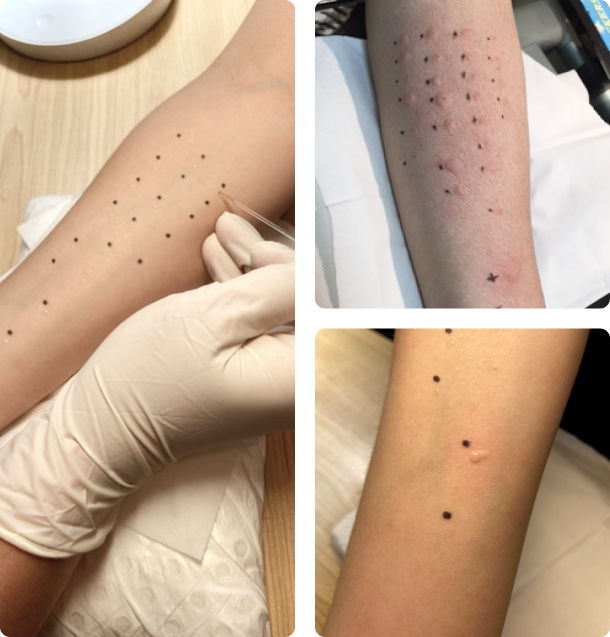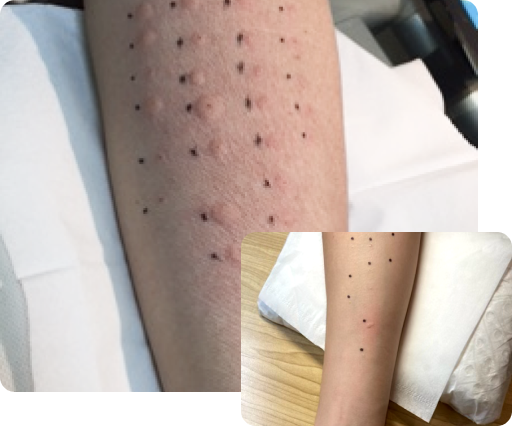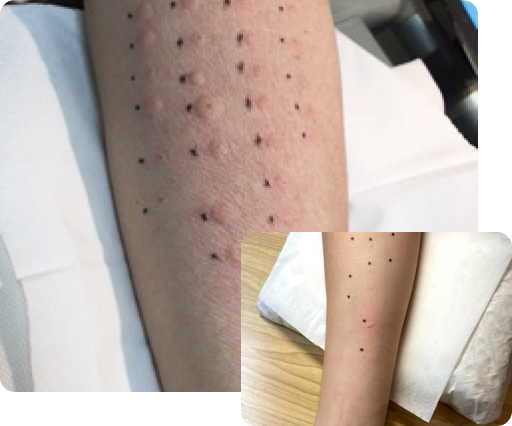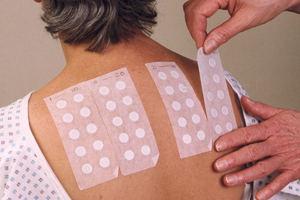Home
Skin Prick Testing Sydney
Home
Skin Prick Testing Sydney

With expert staff, a wide range of allergen tests, modern facilities, and a focus on accuracy and patient care, Allergy Testing Sydney is your top pick for Skin Prick Testing and personalised allergy management.





A skin prick test is used to identify allergies to substances like pollen, mould, pet dander, dust mites, and foods. In this test, a small amount of a suspected allergen is placed on the skin, which is then pricked with a tiny needle. If allergic, a raised bump surrounded by red, itchy skin will develop at the site within about 20 minutes. This helps determine what substances may be causing an allergic reaction.
Skin prick allergy testing is quite accurate, with a sensitivity rate of about 70-90% for detecting specific allergies. However, it can produce false positives, meaning it might indicate an allergy when there isn’t a significant clinical reaction. Results should always be interpreted alongside medical history and possibly confirmed with additional tests.
A skin prick test is usually quick and causes minimal discomfort. The sensation is often described as a brief, minor pricking feeling, similar to a small pinch, which is quite manageable for both adults and children. The test is a straightforward way to pinpoint specific allergies, helping to improve overall health and wellbeing with targeted treatment plans. Most people find the slight discomfort during the test well worth the valuable insights it provides.
A skin prick test introduces small amounts of potential allergens into the skin to check for allergic reactions. During the test, the skin, usually on the forearm or back, is cleaned and several areas are marked to differentiate the allergens being tested. Next, small drops of solutions containing various allergens are placed on these marked areas. The skin under each drop is then gently pricked or scratched with a sterile lancet or needle, allowing the allergen to enter just below the surface. This process is quick and involves minimal discomfort. After the application, you wait about 15-20 minutes to observe the skin’s response. A positive reaction is indicated by a wheal—a raised, round area that looks similar to a mosquito bite—surrounded by redness, which is then measured to assess the severity of the allergy. This test is efficient for detecting immediate allergic responses and helps identify specific substances that might trigger symptoms like sneezing, itching, or skin irritation.
The cost for the appointment which includes consultation with the Doctor and skin prick testing ranges between $300 and $360. Normally, skin prick testing involves testing for up to 15 allergens. However, at Allergy Testing Sydney, we test over 40 allergens on your first appointment. You may also be eligible for Medicare rebates. Patients should verify coverage specifics directly with Medicare or consult our team further to understand the extent of coverage for allergy testing, including any potential out-of-pocket costs.


Extract Taken from www.virtualmedicalcentre.com
A RAST test measures the level of allergen-specific IgE in your blood. That is, it measures the concentration of antibodies your body has created to against a particular food allergen. Interpreting a RAST result is slightly more complicated, however. This is because not everyone with the same concentration of allergen-specific IgE in their blood will react in the same way to the presence of an allergen in vivo (that is, in the flesh).
Someone with a relatively low concentration of allergen-specific IgE may have a fairly severe reaction while someone with a higher concentration of allergen-specific IgE may not react at all — that is, they’re not truly allergic to a food even though the blood test comes out positive. (This is known as a false positive.) RAST tests have a high sensitivity and fairly low specificity, meaning that they have a low rate of false positives and a fair number of false negatives, though this varies by allergen. In general, lower rates of allergen-specific IgE are correlated with a lower chance of reacting in a double-blind food challenge or in a real-world setting, especially if skin test results are negative and if there’s been no history of reaction to a given food.
Different foods have different specific IgE levels that are considered “predictive.” Where most people with a given level of specific IgE may react to one particular food, most people with that same level of specific IgE may not react to another food. Researchers determine these threshold levels by comparing RAST test results to the results of double-blind food challenges in order to find a level of specific IgE on the blood test where a very high percentage of people are truly allergic. This means that someone whose test results “look” identical for two different foods may be considered to have a positive result for one and a negative result for the other, if the foods have different threshold levels.
Specific IgE tests are usually returned in units of micrograms per milliliter (μg/mL). Some, however, are returned on a numerical rating scale (often, but not always, from 0 to 5 or 6). On rated tests, 0 almost always indicates an exceedingly low chance of a true food allergy, while the higher numbers normally mean very strong probability of allergy and a strong likelihood of a severe reaction. Your allergist may use these results to help determine some aspects of your treatment — to see whether a child is showing signs of outgrowing a food allergy, for instance.
Visit us L7 William Bland Centre 229 Macquarie Street Sydney, NSW, 2000
Call us on (02) 9221 1511